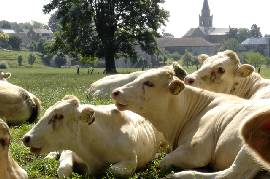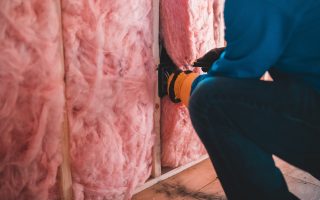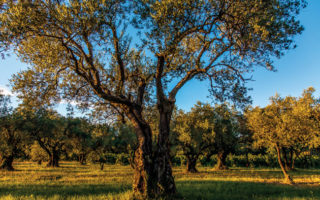How to Keep Cows
Advice


I started keeping cows for their milk, and what I could do with the milk – but now they are my pride and joy. However, cows are by far the greatest responsibility any smallholder will ever have they will cost and require more attention than any other stock you could keep.
The Upside
A cow can be as versatile as you want her to be – she can provide you with milk, cream, butter, cheese, ice cream as well as beef. From little more than good quality pasture and good hay, one cow can provide for the whole family and two can provide for the family and produce a valuable surplus.
The Downside
Cows are the most expensive of all livestock and an investment, which could take years to realise, so it is not a choice to take lightly. Depending on the size of the animal you choose it will need one to two acres of pasture to feed it, one acre for grazing and one to cut for hay. Here in France it will have to be blood tested on arrival at yourholding and then again every two years, at your expense. Milking a cow is a twice a day 365 days a year is an endeavour, and finding someone to cover your absence for any reason is not easy.
How to Get Started
First you must consider carefully all the possible options. Is your cow for beef only for just for milk; or are you after a dual-purpose cow for both milk and beef?
This is one question worth taking your time over. A good beef cow may not give you good quality milk or a great deal of it either; a good quality milk cow may not give you good quality beef.
One of the best known of the milk cows is the Jersey, and she deserves her reputation for good quality milk, with one of the best butterfat to milk ratios you will find. But she will not give you good quality beef.
Even if you cross a Jersey with a beef bull she will still give you poor quality beef calves, that will neither fetch a good price at market or provide you with beef you feel is worth boasting about at the table when entertaining guests.
Hereford beef is renowned throughout the world but the cows are aggressive and the bulls even more aggressive so trying to milk one is far from practical.
Friesian cows are great milk cows. I would guess most readers have a picture of one well fixed in their mind from childhood. They are, however, poor for beef production and although their milk yield is greater, it is of a lesser quality in comparison to a Jersey.
A dual-purpose cow like a Dexter will give you good quality milk and good quality beef, but it is a small breed and consequently will not provide you with a large amount of either.
Another important point is geography. Some cows are more suited to the weather conditions in your region that others. For example, it would be tough for a highland cow from the cooler regions of central France to have to endure a regular temperature of 42°C in a southern summer.
Buying locally has three advantages – your vendor could be a neighboure and therefore become a constant source of advice; a local cow will probably be cheaper to acquire than one from farther a field; and it will be acclimatised to the local weather.
Normande cows are readily available here in central France and for no other reason than that, I purchased two of them, from a neighbour in my village, who has been a constant help throughout. Normande cows produce very high quality milk and nearly double that of a Jersey cow and the beef from the bulls is a market leader for price. If you cross them to beef bulls even the heifer calves will command a good price at market. I however enjoy nothing more than having guests share our produce with us and hear them rave about the quality knowing we produced that on our own land from our own beasts.
Housing Needs
Cows can and in some cases do live outside all year round. However if you wish to keep you pasture in good order in wet regions you will almost certainly need to keep them off of your ground for at least 3 months of the year.
In mid-Wales the local farmers would take cows inside in October and may not return the cows to pasture until May. Here in central France we take our cows in as late as December and we can sometimes return them as soon as March but certainly by April.
To do this you will need at least a corral on well drained soil, but as we milk our cows we also need a cow shed although admittedly this is for our own comfort as milking outside in –15°C temperatures is a little uncomfortable to say nothing of rain, snow, and north winds.
In truth, for our two cows we have a cowshed that occupies half of our barn about 4 meters by 10 meters and we house our cows here for the winter and milk them here too. Now you have two choices deep litter or not.
Deep Litter
Deep litter simply means you keep adding bedding material to the cowshed, so the cows do not lie in their own muck. I do not advocate this for several reasons – one I would not like to do it myself; two the litter will start to compost with in a week and the resultant heat will make the atmosphere unpleasant; three within a month the gasses from the deep litter can cause respiratory problems for the cow leading to the use of drugs as a matter of course, leading to an added cost for upkeep of livestock, and four the resultant half meter of compost is real hard work to remove, unless you have unnecessary and expensive equipment.
If you choose not to deep litter you have to clean out the cowshed every day and take away the mixture of straw and muck and store it else ware to compost. This is the best compost you will ever have for your garden, and add any other garden and kitchen waste, hedge cuttings, chippings, leaf mould etc, and you will enjoy a compost which no shop can match. Its free and its organic. But it is also hard work!
Feeding
This is not simple although it sounds simple to say they need little more than good quality pasture and hay made from more good quality pasture.
Good Quality Pasture
Pasture is more much more than just grass; pasture is a complex mixture of grasses and wild flowers. Imagine if your diet consisted of the same thing day in and day out without any variation at all… well it’s the same for your cow x 10. Not because she is more sensitive to dietary change but because she is producing food; her milk will only be as good as the pasture you put her on. If the pasture is lacking in some of her dietary needs she will produce poor quality milk; if it is very poor she will produce even poorer quality milk. The secret to good quality milk is good clean pasture. Here are just some of the different things that could make up your pasture:
Grasses: Common bent, Sweet vernal grass, Crested dogs tail, Red fescue, False oat grass, Smooth meadow grass, Rough meadow grass.
Wild flowers: Yarrow, Common knapweed, Pignut, Lady’s bedstraw, Cat’s-ear, Meadow vetchling, Autumn hawkbit, Oxeye daisy, Common birds foot trefoil, Ribwort paintain, Self heal, Meadow buttercup, yellow rattle, common sorrel, Devel’s bit scabious, Red clover, Germander speedwell, Tufted vetch.
Clean Pasture
This is as complex as good quality pasture. Clean pasture is not just pasture that looks good; it is the product of good pasture management and this involves rotating your pasture so your livestock are not back on the same ground year after year. The simplest way to manage this is to graze pasture one year and cut it for hay the next, and then rotate back. You may also want to put other stock on this pasture in another year. sheep for example if you have some, as the parasites which can affect cows will not thrive in sheep and vies-versa.
Water
Water is a hugely important part of the diet of a cow she can drink as much as 30 litres a day and in hot weather even more. Cows are very good at communicating their needs and if ours bellow during the day it is usually because we have forgotten to fill the water troughs!
Steve Hanson
Share to: Facebook Twitter LinkedIn Email
More in courses, family, food, garden, summer, villages, work
By FrenchEntrée
Leave a reply
Your email address will not be published. Required fields are marked *




REPLY